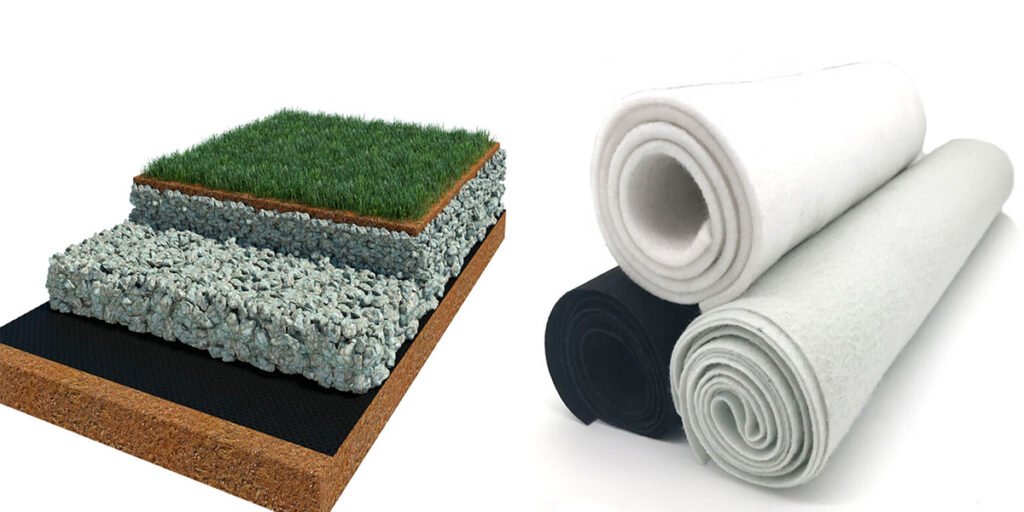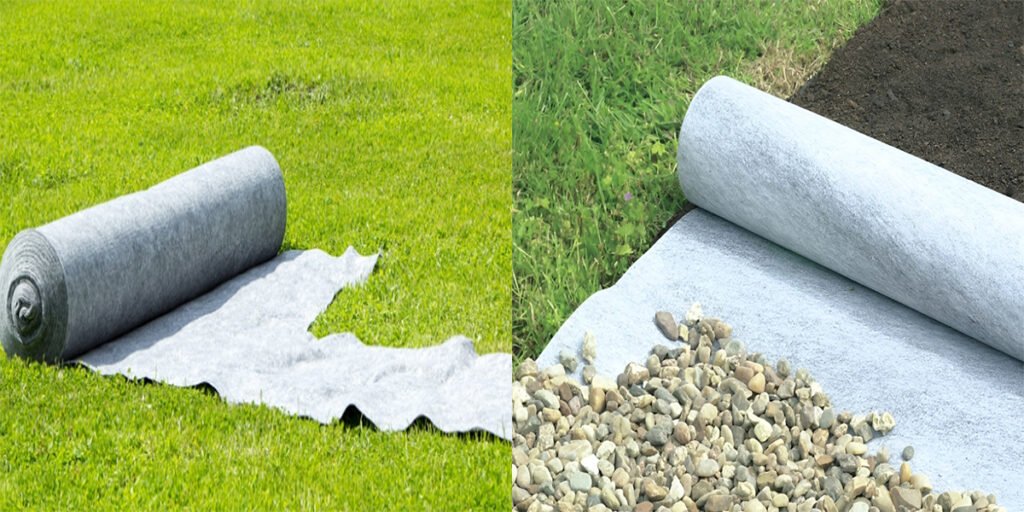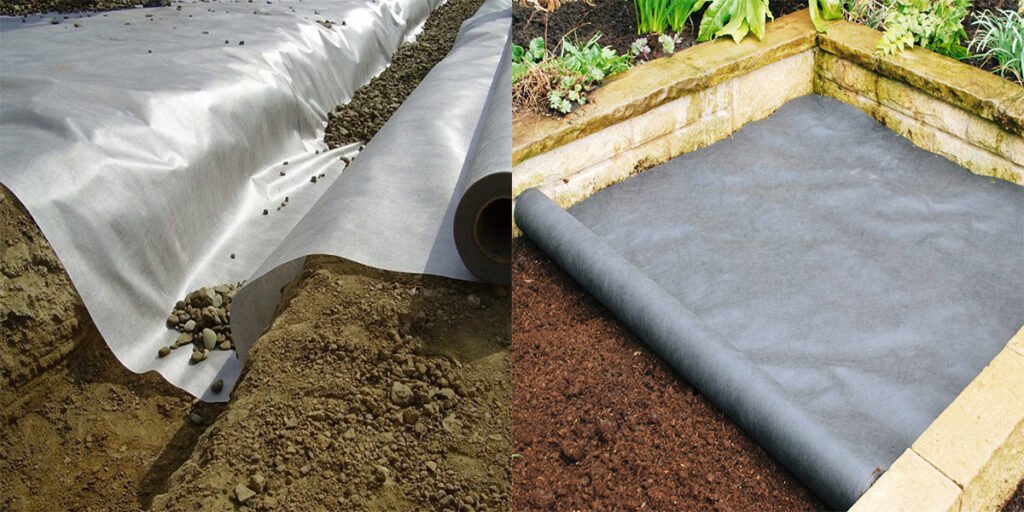What is non woven landscape fabric ?
Non woven landscape fabric Improves Soil Health is a kind of fabric made of synthetic fibers such as polyester (PET), polypropylene (PP) and other materials. Its main feature is the non-woven structure. The fibers are formed into a tight, non-woven mesh structure by mechanical, thermal, chemical and other means. Unlike traditional fabrics, non-woven landscape fabrics do not need to be connected by weaving or sewing, so they are more flexible and breathable. The fabric is specially treated to ensure that it has sufficient durability and can be used in outdoor environments for a long time without being easily damaged or aged. The application of Non woven landscape fabric can not only improve soil quality, but also effectively inhibit the growth of weeds and provide a more suitable growth environment for plants.

How nonwoven landscape fabric improves soil health
- Improve soil permeability; Non woven landscape fabric provides excellent air channels through its special structure, which can effectively improve soil permeability. After covering the planting area with non-woven landscape fabric, air and water can flow freely, which helps to improve soil permeability, and the roots can get enough oxygen to promote healthy plant growth. Soil with good air permeability can avoid root rot caused by excessive water accumulation or lack of oxygen.
- Improve soil moisture retention; Non woven landscape fabric effectively helps the soil retain moisture. It can reduce water evaporation and keep the soil at an appropriate moisture level. In the dry season, the soil covered with non-woven landscape fabric can better lock in moisture and avoid plants drying up due to water loss. Non woven landscape fabric can also prevent the surface of the soil from being blown away by the wind, further reducing water loss. The moisturizing effect is very important for plant growth, and requires plant areas with higher humidity, such as gardens, lawns, etc.
- Prevent soil erosion; soil erosion is the phenomenon that soil particles are lost due to rain or wind erosion, which is particularly serious in slopes or low-lying areas. Non-woven landscape fabrics can effectively prevent water from directly eroding the soil and protect the soil surface. The barrier formed by the fabric on the surface can reduce the erosion of the soil by external water flow, thereby protecting the soil structure from being destroyed.
- Improve the temperature regulation ability of the soil; Nonwoven Landscape Fabric have a certain temperature regulation effect. In extreme weather (such as hot summer or cold winter), non-woven fabrics can help regulate soil temperature and avoid damage to plant roots caused by temperature fluctuations. A protective barrier is formed on the soil surface to reduce the damage caused by excessive temperatures caused by direct sunlight or low temperatures caused by cold weather.
- Promote the accumulation of organic matter and nutrients; the use of non-woven landscape fabrics can reduce the growth of weeds and prevent them from competing with plants for nutrients. Over time, organic matter and nutrients in the soil gradually accumulate, allowing plants to obtain more sufficient nutrients. In addition, the interaction between organic matter in the soil (such as humus) and plant roots also contributes to the health and fertility of the soil.

Application Cases
- Garden and horticultural projects; Non woven landscape fabric are widely used in home gardens and commercial horticultural projects to control weeds and improve soil health. By covering the soil surface, nonwoven landscape fabrics can effectively prevent the growth of weeds, while promoting water retention, keeping the soil moist, and facilitating plant growth.
- Lawn construction; Non woven landscape fabric are also important in lawn construction, used to isolate the grass roots and soil of the lawn, prevent weed invasion and reduce lawn maintenance work. By preventing the loss of water and nutrients in the lawn, it promotes the healthy growth of the lawn.
- Land and slope protection; Non woven landscape fabric can be used to prevent soil erosion and protect the land surface. By providing an effective protective layer for the soil, it avoids erosion caused by rain or wind, and helps maintain the stability of soil structure and land.
- Landscaping and urban greening; In urban greening and landscaping, nonwoven landscape fabrics can be used as the base layer of flower beds and green spaces to help improve plant growth conditions, reduce weed growth and reduce maintenance workload. It can serve as a barrier to prevent soil pollution and maintain soil health.
- Water management and drainage systems; Non woven landscape fabric are widely used in water management and drainage systems, especially in waterproofing, drainage and infiltration projects. It can effectively promote water circulation and filtration, help remove excess water, and prevent soil particles from entering the drainage system.
- Soil remediation and land reclamation; Non woven landscape fabric are also used in soil remediation and land reclamation projects. Provide a protective barrier for the soil, reduce the penetration of pollutants and improve soil stability. Non woven landscape fabric play an important role in the restoration of abandoned land, contaminated areas or degraded soils.
- Road and highway engineering; Non woven landscape fabric are used for roadbed reinforcement, drainage and prevention of soil erosion. It can ensure the long-term durability of the road by improving the stability of the pavement structure, enhancing the water discharge capacity and preventing the pavement from sinking.
- Farmland and agricultural applications; Non woven landscape fabric are also widely used in the agricultural field, especially in greenhouse cultivation, plant protection and soil protection. It can prevent water loss, inhibit weed growth, increase soil temperature and protect plants from the influence of the external environment.

Non woven landscape fabric FAQ
1. What is non-woven landscape fabric?
Non-woven landscape fabric is a type of fabric that is commonly used in gardening, landscaping, and erosion control projects. It is made from synthetic fibers, typically polypropylene (PP) or polyester (PET), which are bonded together through a mechanical, thermal, or chemical process. This fabric is porous, allowing water and air to pass through, while preventing weeds from growing and protecting the soil from erosion.
2. What is the difference between woven and non-woven landscape fabric?
- Woven landscape fabric is made by weaving fibers together in a crisscross pattern, providing strength and durability but less flexibility and breathability. It is typically used in heavy-duty applications like roadways and large-scale landscaping projects.
- Non-woven landscape fabric, on the other hand, is made by bonding fibers together without weaving, making it more flexible, breathable, and easier to install. It is commonly used for weed control, erosion prevention, and soil stabilization in smaller-scale projects like gardens and flowerbeds.
3. How does non-woven landscape fabric help with weed control?
Non-woven landscape fabric helps with weed control by creating a physical barrier between the soil and weeds. The fabric blocks sunlight, which prevents weeds from germinating and growing. It also allows water, air, and nutrients to reach the soil, keeping the plants healthy while stopping weeds from competing for resources.
4. Can non-woven landscape fabric be used under mulch or gravel?
Yes, non-woven landscape fabric can be used under mulch, gravel, or other types of ground cover. When placed beneath mulch, it helps to keep the mulch in place, prevents soil from washing away, and stops weeds from growing through. It also allows for proper drainage, making it an excellent choice for areas with heavy foot traffic or where gravel is used for decorative purposes.
5. How long does non-woven landscape fabric last?
The lifespan of non-woven landscape fabric depends on the quality of the material and the environmental conditions. Generally, high-quality non-woven fabrics made from polypropylene or polyester can last anywhere from 5 to 10 years under typical gardening or landscaping conditions. In areas with high UV exposure or extreme weather, the fabric may degrade more quickly, but some fabrics are UV-resistant and can last even longer.
6. Is non-woven landscape fabric biodegradable?
No, non-woven landscape fabric is typically not biodegradable, as it is made from synthetic materials like polypropylene or polyester. However, some manufacturers offer eco-friendly versions of Non woven landscape fabric that use biodegradable fibers, making them a more sustainable option. It’s important to check product labels or consult with manufacturers if environmental impact is a concern.
7. Can non-woven landscape fabric be recycled?
Non woven landscape fabric is not always recyclable due to the synthetic materials used in its construction. However, some fabric made from polypropylene (PP) or polyester (PET) may be recyclable in specific facilities that accept these materials. Be sure to check with local recycling centers to determine if they accept landscape fabric for recycling.
8. How do I install non-woven landscape fabric?
Installing Non woven landscape fabric is relatively simple and requires a few basic steps:
- Prepare the area: Clear the area of weeds, rocks, and debris.
- Lay the fabric: Unroll the fabric over the prepared area, ensuring that it covers the soil completely. Overlap the edges by several inches to prevent weeds from growing between seams.
- Anchor the fabric: Use landscape fabric staples or pins to secure the fabric to the ground. Place staples along the edges and seams to keep it in place.
- Cover with mulch or gravel: Add a layer of mulch, gravel, or other ground cover over the fabric to help keep it in place, protect it from UV rays, and improve its aesthetic appeal.
9. Can non-woven landscape fabric be used on sloped areas?
Yes, Non woven landscape fabric can be used on sloped areas to prevent soil erosion and control weeds. When applying fabric on slopes, it is especially important to anchor the fabric securely using landscape staples or pins to prevent it from shifting. You may also want to cover the fabric with a heavier layer of mulch or gravel to help keep it in place on the slope.
10. Will non-woven landscape fabric prevent all weeds from growing?
While Non woven landscape fabric is effective at preventing many types of weeds from growing, it is not a complete solution for all weed problems. Some aggressive weeds with deep roots or those that spread through seeds from above the fabric may still be able to grow. Regular maintenance, including the removal of any weeds that appear on the fabric surface, is recommended for optimal performance.
11. Can I use non-woven landscape fabric for erosion control?
Yes, Non woven landscape fabric is an effective material for erosion control in both large and small-scale projects. It helps stabilize the soil, especially on slopes and in areas that are prone to water runoff. The fabric prevents soil from being washed away by water, while allowing water to pass through and drain properly. In some cases, non-woven fabrics are used in combination with other erosion control measures, such as mulch or grass seeding.
12. How do I clean non-woven landscape fabric?
Non woven landscape fabric generally does not require regular cleaning, as it is designed to be durable and low-maintenance. However, if dirt or debris accumulates on the fabric, you can clean it by gently hosing it down with water or using a soft brush to remove any buildup. Avoid using harsh chemicals or abrasives that could damage the fabric.
13. Can non-woven landscape fabric be used in gardening or planting beds?
Yes, Non woven landscape fabric is widely used in gardening and planting beds to improve soil health, prevent weed growth, and enhance water retention. By placing the fabric under mulch or other ground covers, gardeners can reduce the time and effort spent on weeding while providing a healthy growing environment for plants.
14. Is non-woven landscape fabric safe for plants?
Yes, non-woven landscape fabric is safe for most plants. It allows water, air, and nutrients to pass through to the soil, ensuring that the plant roots remain healthy. However, it’s important to ensure that the fabric is installed correctly and that there is sufficient space for plant roots to grow. If the fabric is too tightly packed or if the soil underneath is poorly drained, it could potentially affect plant growth.
15. Can I reuse non-woven landscape fabric?
Non-woven landscape fabric can be reused if it is still in good condition. If the fabric has not been damaged or degraded, it can be carefully removed, cleaned, and laid down again for future use. However, repeated installation and removal may affect the fabric’s longevity, so it’s important to inspect it before reusing it to ensure it is still functional.
